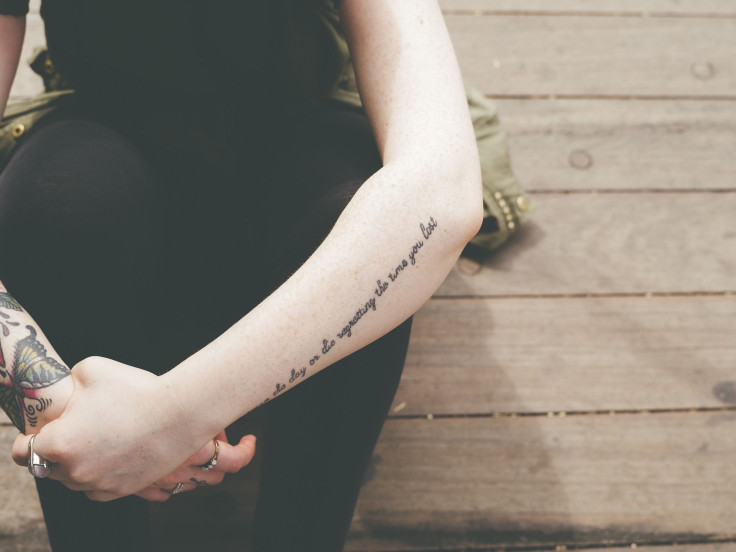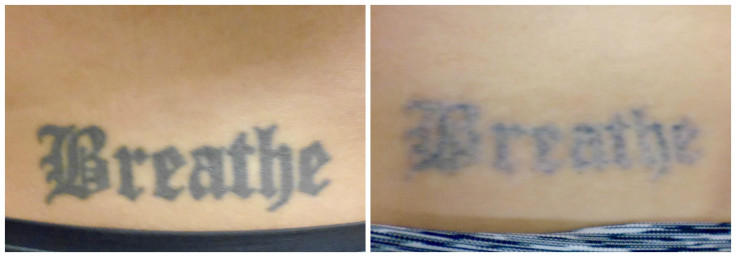Laser Tattoo Removal Before and After: What It’s Like To Erase Your Ink

I am the cliche of the rebellious teenager with a tattoo who grew up to be a young adult with regret. Two weeks after my 18th birthday — the golden age when you know everything and you’re always right, despite your mother’s lament warnings — I sat proudly in a tattoo chair. I remember lying down on the taut black leather recliner with satisfaction as the gun flickered to life with a high-pitched hum, and shot a delicate yet rhythmic pain deep into my back.
I had come up with the design for my tattoo two years prior, which led me to believe I’d be ready by the time I was legally old enough to get the ink. After I got off the black recliner and went home that night with a big white bandage taped under my shirt like a wonderful secret, I thought I had made the right choice. But it only took a few years before the novelty of my permanent decision began to fade. Unfortunately, the tattoo didn’t fade with it.
For eight years, “Breathe” has been scrawled across my back in Old English font, a gentle reminder to stay calm and collected. But now, every time I look in the mirror, craning my neck over one shoulder, I feel anything but calm. One day the word transformed itself into a scar of weakness instead of a tool for strength. I no longer wanted to remember why I needed it in the first place.
Still, I continued to wrestle with whether or not to get it removed; it's been with me through the hardest chapters of my life so far, and served its purpose through the stress. It’s a part of me, I thought. But because removing the tattoo was a more permanent decision than getting it in the first place — a paradoxical position for those of us wearing ink — I felt stranded, vacillating between whether or not to let it go.
It wasn’t until this year that I was finally ready to erase the teenage angst off my body and join the nearly 50,000 people who undergo tattoo removal procedures each year. I decided to call the only person I would trust to do it, Dr. Cameron Rokhsar, a cosmetic laser surgeon, board-certified dermatologist and the medical director at New York Cosmetic, Skin & Laser Surgery Center.
After working with him for two years, I saw firsthand the exceptional quality of his work and the patience and care he has for his patients. I knew he would make me feel at ease, explain the entire process with clarity, and above all not pass judgement. In fact, he reasurred me I was among the average age of patients who seek tattoo removal procedures today. After looking at my tattoo, he told me I was an ideal candidate because black tattoos without any color respond best to laser treatments. However, I would still have to undergo eight or more sessions to have it fully removed.
Erasing The Ink
I walked into my first appointment at Dr. Rokhsar’s Upper East Side Manhattan office six months ago, said hello to my favorite receptionist, and made my way down the hallway. His medical assistant took a photo and cleaned the tattoo in preparation for the lidocaine injections that would numb the area. I felt a flicker of indecision, but I quickly resolved to move forward. I braced myself for the pain of the needle, but felt only tiny pinches instead.
Next, Dr. Rokhsar explained how the Q-switched laser he was going to use worked. The high-intense pulse beam would fire at a fraction of a second to break up the tattoo particles small enough for my immune system to naturally flush out, while also stimulating new collagen production over time.
I was pleasantly surprised to find I felt virtually no pain — at all — as I lay smiling with eye-protective goggles on. Before I began this journey, I expected months of agony, but after what seemed like a few minutes, the first session was done. While the area was being dressed with petroleum jelly and a bandage, I focused on talking to Dr. Rokhsar, who has more than a decade of laser surgery experience, about the world of tattoo removal.

What You Need To Know Before Your First Appointment
“We see issues with tattoo removals all the time, where patients come in and say they had a bad experience because they went to a med spa and weren’t treated by a doctor,” he said. “Their tattoo removal was very painful or not done properly, which often leads to scarring. If you’re not a physician, you’re not properly trained with the correct techniques.”
I then asked Dr. Rokhsar what advice he had for those suffering from tattoo remorse and are ready to take the first step in the removal process. He said when you set up an appointment, make sure they can administer lidocaine, which is what’s injected to numb the area prior to the laser. If you experience pain during the procedure, it’s because they are legally not allowed to administer the medication without a medical license. Instead, they’ll use a topical numbing cream that doesn’t work beneath the skin’s surface. The reoccuring problem in the tattoo removal industry remains for people who go to non-physicians out of desperation because it's less expensive. However, they run a high risk of pain, infection, and permanent scarring that's often worse than the tattoo itself.
“If there’s no MD there to treat you, you should not be there,” Dr. Rokhsar warned. “This is a medical procedure that should be handled by a physician who specializes in laser tattoo removal. Do you want a pediatrician shooting you with a laser? Do you want a dermatologist treating your heart attack? No, we’re trained in our proper fields, which is why you need to see a physician who is either a board-certified dermatologist or board-certified plastic surgeon.”
I made an appointment scheduled four weeks later to allow time for my skin to heal and thanked Dr. Rokhsar for all of his help and advice. With the lidocaine wearing off, I walked out the door and made my way to the subway just as a warm sunburn feeling arose on my back along with a sense of accomplishment. The initial pride I felt from getting my tattoo all those years ago and my newfound confidence from its removal were in stark contrast with one another. Session by session, layer by layer, I would find my way back to myself.
When you're 18 and blinded by your own naivety, you can't see how much more growing you have left to do. I used my tattoo as a lifeboat, but I've finally reached the shoreline. Barely a decade after I made the initial decision to get my ink, I know I still have more to learn and explore. The difference is that now I don't need a reminder to help me get to where I'm going.
Although I’m only halfway through my sessions, the entire process has been simple, painless, and an overall success. Tattoo removal had always seemed like a daunting procedure to me because of the horror stories born out of spas and clinics where people aren’t properly trained or licensed to inject lidocaine, let alone wield a laser beam. After Dr. Rokhsar pulled back the curtain on the precarious practices of tattoo removal, I realized how important it was to have the correct information out there for those who are ready to erase their ink and uncover a clean slate.



























